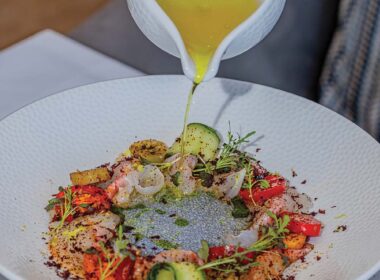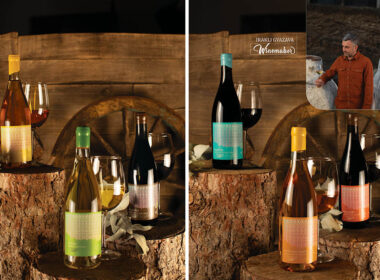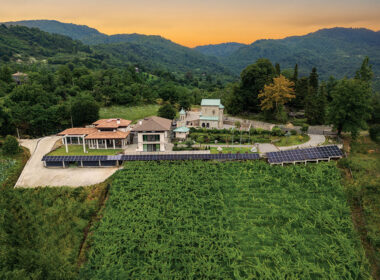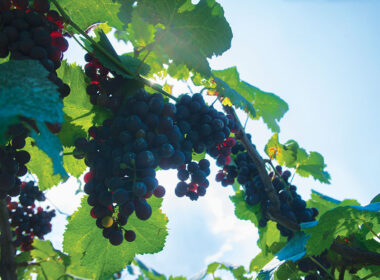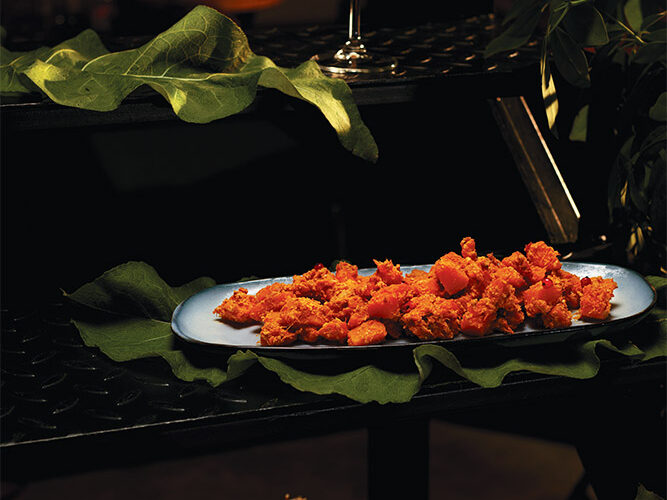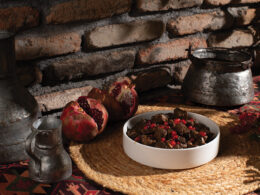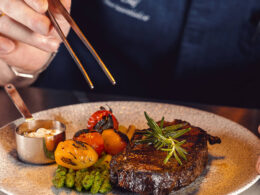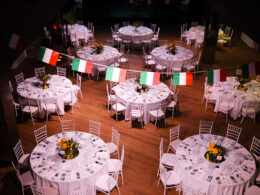| Homeland of Wine Magazine |
By Keti Kvichidze
Racha is located in the northeastern part of western Georgia. For centuries, wheat, barley, and oats were cultivated in this region, which is why bread baking became a profession here, and the people of Racha were known as skilled bakers. Upper Racha was well-known for cattle breeding, while Lower Racha became famous for its viticulture and winemaking. Our upcoming exploration will focus specifically on this region and its gastronomy.
In the village of Kvatskhuti in Ambrolauri, we visited Melitoni Winery and met Giorgi Skhirtladze, winemaker and owner of the establishment. Giorgi’s ancestors come from Mravaldzali, a picturesque village perched at 1,800 meters above sea level. In this high mountainous region, the people of Racha practiced winemaking, transporting grapes from the lowlands by oxcart to craft their wine.
When Giorgi’s great-grandfather Melitoni was in the lowlands, his wife Tamara tended to the wine, a daily task that required the demanding work of stirring the qvevri. It is thanks to Melitoni and Tamara, that Giorgi continues the winemaking tradition. He also learned how to prepare traditional Rachvelian dishes from his grandmother.
It’s intriguing to explore what the people of Racha enjoyed with their local wines. We discussed the region’s traditional dishes with Khatuna Gelovani, a researcher of local gastronomy.
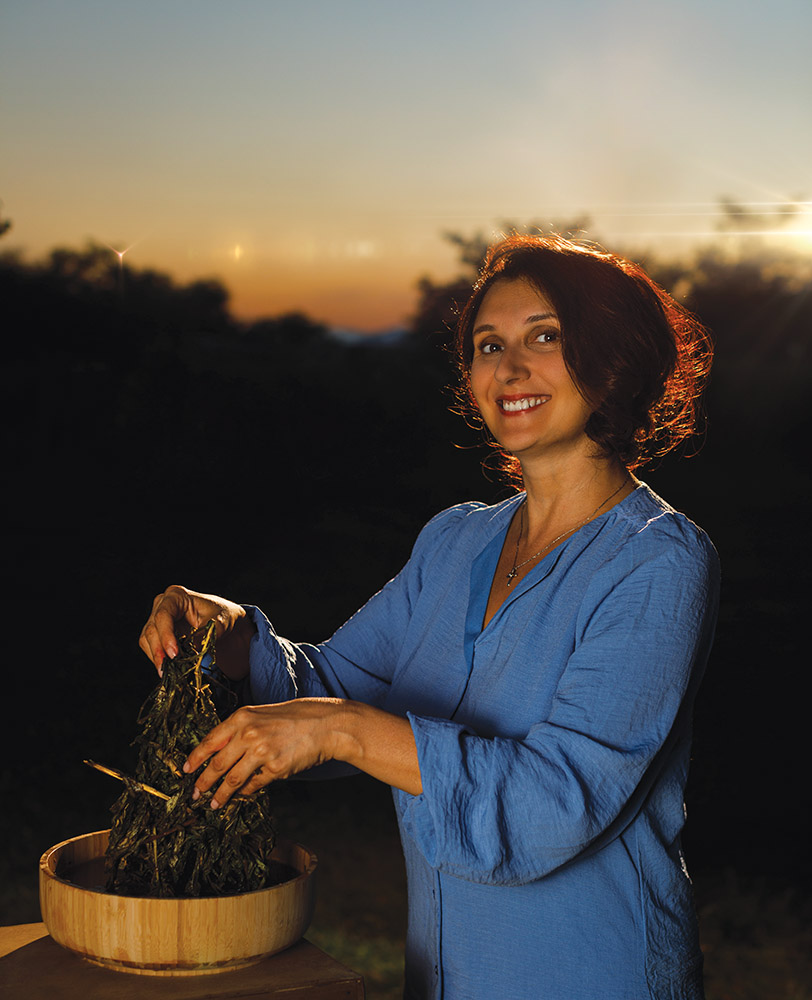
“One of the main products the people of Racha take pride in is Rachvelian ham , which is made from pork. The region’s oak forests and the acorn-fed, free-range pigs give the ham its distinctive flavour. The process begins with slicing the pork loin into pieces known as ‘pelika.’ These pieces are then layered on a wooden board after being dipped in hot brine. They then cover the top with a piece of sackcloth, which protects the meat from contamination while allowing air circulation. After 7-8 days, the pieces are turned over and left for another week. Next, the meat is hung near a medium heat source for 3-4 days to allow the juices to drain. Finally, they light a low fire using tkemali (wild plum) or oak wood to smoke the meat. The smoking process lasts for one month.”
Khatuna Gelovani recommended using oak wood for smoking to achieve golden colored ham.
The people of Racha keep ham throughout the year as a traditional festive dish. When the ham is ready, it signifies that winter has been successfully weathered. Ham can be enjoyed both straight and cooked. It is often prepared as a stew or added to lobio (Georgian bean stew), enhancing the flavour of both lobio and lobiani (traditional bean-stuffed pastries).
Lobio (bean stew) is a cherished dish among the locals, and the mere mention of it brings a sparkle to any Rachvelian’s eyes. It is enjoyed both as a stew and as a dry dish (kirkazhi). Lobio is also used to make the renowned lobiani, a stuffed pastry that is either baked in a tone (traditional oven) or pan-fried.
Lobiani is not only a daily dish but a ceremonial one, playing a central role in the celebration of ‘Barbaloba,’ a tradition observed throughout Georgia. Ivane Javakhishvili, a prominent Georgian historian and scholar, noted that before beans (lobio) were introduced to Georgia from America, the locals consumed a grain called tsulispira. This grain required lengthy cooking times and was more difficult to cultivate, which is why it has been replaced by lobio over the centuries.
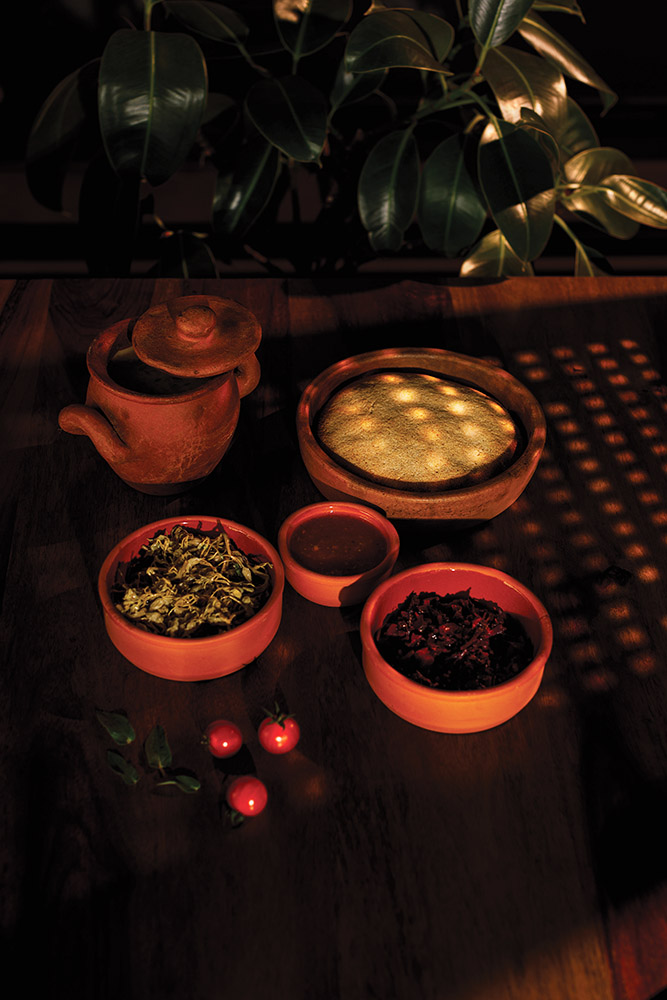
Rachvelian-style lobio is made by boiling beans, changing the water at least twice during the process. Onions and garlic are sautéed in pork fat and then mixed into the beans. Coriander, pepper, parsley, celery, and either dill or thyme are added, and the mixture is mashed thoroughly before being served with mchadi (cornbread). This dish pairs particularly well with various pickles, including jonjoli (bladdernut), which is drizzled with oil, topped with chopped onions, and served.
Shkmeruli is a traditional Rachvelian dish originally known as chicken in garlic water. Garlic, valued for its antibacterial properties, was commonly used in cooking to prevent spoilage, particularly of chicken meat during the summer. The dish was named shkmeruli by chef Grigol Gagnidze, who hailed from the village of Shkmeruli and worked in a Tbilisi restaurant in the 1950s. He introduced milk to the garlic water, giving the dish its current name. Today, shkmeruli is enjoyed not only in Georgia but around the world.
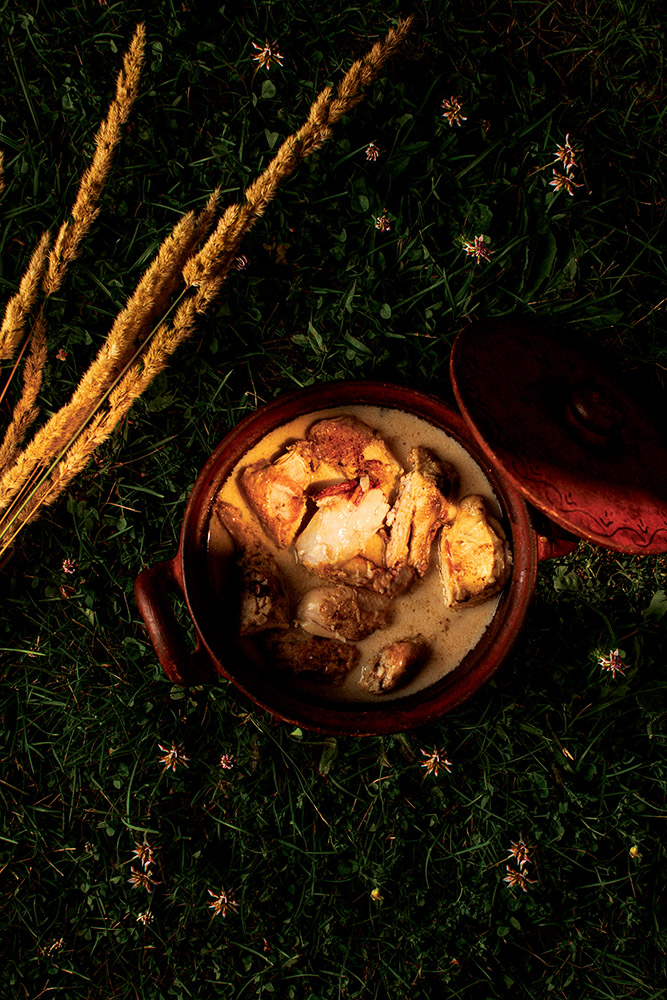
Bughlama is a traditional Rachvelian dish made from the plant known as qalakoda (Arum orientale). Qalakoda, a member of the iris family, is dried in summer for use in winter. The preparation involves simmering tkemali (wild plum sauce), then adding crumbled dried herbs and flour, and cooking everything together. Garlic, coriander, salt, and pepper are added to taste. Locals claim that bughlama is the best remedy for a hangover.
Like other regions of Georgia, Racha is rich in stuffed pastries, including bochkhuani and brachuli (square and cross-shaped khachapuri), kada-khacha (Georgian sweet pie with cheese), sheketsila (bread with walnut filling), ganatekhi (dough rolled with walnuts, also baked for ritual purposes), mkhaliani (pastry with a leafy green filling), and Ghebi’s 3 cheese khachapuri, among others.
Ghebi, located in Upper Racha, is renowned for its breathtaking natural beauty. Both the atmosphere and the cuisine are exceptional. The method for preparing rdzi-tavi (a type of cheese) in Ghebi resembles that of crème fraîche and is unique to this region of Georgia. Rdzi-tavi is crafted from boiled milk cream, and the cheese produced in Ghebi is particularly esteemed for its quality as well.
A distinctive dish from mountainous Racha is tskaldaskhmula, made with curd. The curd is stored in a large container, which is weighed down to press out excess moisture. To prepare tskaldaskhmula, you’ll need pieces of mchadi (corn bread), a spoonful of ghee, and several tablespoons of curd. The ghee and curd are mixed into boiling water, then the cornbread is soaked in this mixture, and the dish is ready to enjoy.
Jorma is a distinctive and unusual dish made from pork or lamb rumen. The rumen is carefully cleaned and then stuffed with a mixture of herbs and lamb’s fat tail, similar to the way dolma is prepared. To keep it intact, the stuffed rumen is wrapped with string and boiled in a large pot. Once cooked, jorma is sliced and served.
Baduri is a traditional dish from Upper Racha made with pig intestines. The intestines must be thoroughly cleaned, inflated, and tied at both ends. They are then left to dry in the sun. Once dried, the threads used to tie the ends are removed, leaving the intestines puffed. They are then filled with a mixture of fried or boiled ground meat (or both) and krichkhoni which is the term Rachvelians use for the fat and browned remnants left in the pan after cooking meat. The intestines are seasoned with various spices according to taste, such as salt, red pepper, or black pepper. The stuffed intestines are stored in a cool, dry place. They are enjoyed in winter, heated in a pan, and served with tkemali (wild plum sauce) and bread.
Rachvelians are also passionate about plant-based dishes, using ingredients such as nettles, qalakoda (Arum Orientale), ground ivy, wild garlic, and dandelions. They possess a deep knowledge of mushrooms, with a particular fondness for machkvinara (honey mushrooms.) They also prepare kvakhitsela from pumpkin.
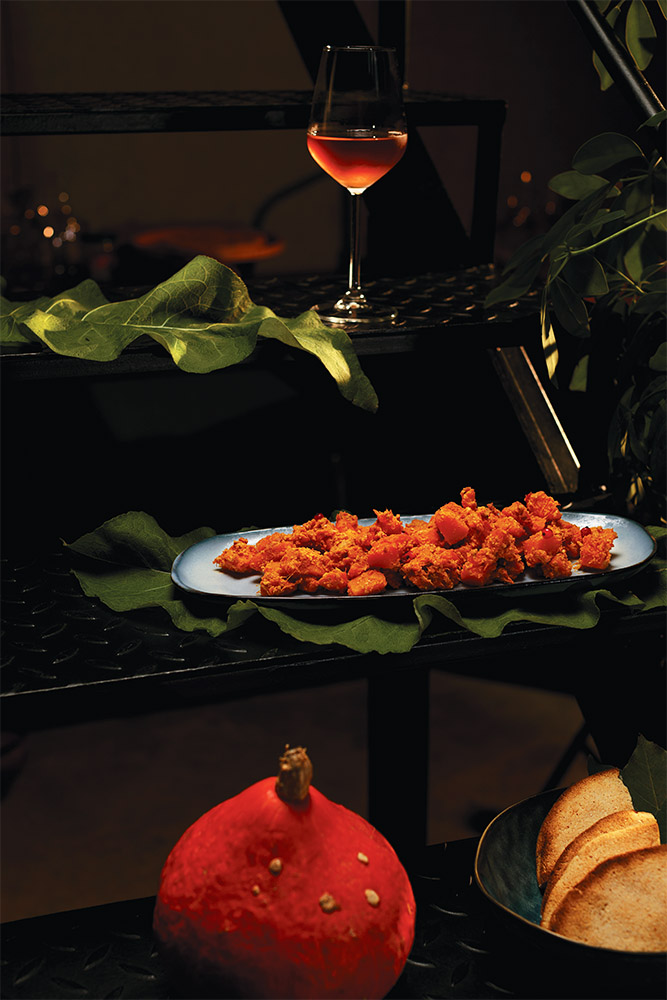
Khatuna Gelovani, while others were made with the winemakers from Melitoni winery. The Rachvelian dishes were especially complemented by Aleksandrouli wine from this winery.
რაჭა – ჩემი სიყვარული
ქეთი კვიჭიძე
რაჭა დასავლეთ საქართველოს ჩრდილო-აღმოსავლეთ ნაწილში მდებარეობს. ამ მხარეში, საუკუნეების განმავლობაში მოჰყავდათ ხორბალი, ქერი და შვრია. ამიტომაც რაჭაში პურის ცხობა პროფესია იყო, რაჭველები კი ცნობილი ხაბაზები. ზემო რაჭა მესაქონლეობით, ქვემო რაჭა კი მევენახეობა-მეღვინეობით იყო განთქმული. ჩვენი მორიგი ექსპედიცია სწორედ ამ რეგიონსა და მის გასტრონომიას ეხება.
ამბროლაურში, სოფელ კვაცხუთში, მეღვინეობა მელიტონში გიორგი სხირტლაძეს ვესტუმრეთ, რომელიც ამავე მეღვინეობის მფლობელი და მეღვინეა. გიორგის წინაპრები მრავალძალიდან არიან. ეს ულამაზესი სოფელი ზღვის დონიდან 1800 მეტრზე მდებარეობს. ამ მაღალმთიან მხარეში რაჭველები მეღვინეობას მისდევდნენ. დაბლობიდან ყურძენი ურმებით აჰქონდათ და ღვინოს აყენებდნენ. გიორგის დიდი ბაბუა მელიტონი თუ ბარში იმყოფებოდა, ღვინოს მისი მეუღლე თამარა უვლიდა, რაც არცთუ ადვილ საქმიანობას – ქვევრის დარევას გულისხმობს. სწორედ მელიტონისა და თამარას დამსახურებაა, გიორგი მეღვინეობის ტრადიციას რომ აგრძელებს. რაჭული კერძების მომზადებაც ბებიისგან ისწავლა.
საინტერესოა, რას მიირთმევდნენ რაჭველები რაჭულ ღვინოებთან ერთად. აქაურ კერძებზე ადგილობრივი გასტრონომიის მკვლევარ ხათუნა გელოვანს გავესაუბრეთ.
“ერთ-ერთი მთავარი პროდუქტი, რითიც რაჭველი თავს იწონებს, ღორის ხორცისგან დამზადებული რაჭული ლორია. რაჭაში მუხის ტყეებია, აქაური ღორიც ველურად, რკოზეა გაზრდილი, რაც ლორის განსაკუთრებულ გემურ თვისებებს განაპირობებს. რაჭველები ღორის ზურგიელს ფელიკებად ჭრიან და ხის გობზე, ცხელ მარილ-წყალში ამოვლებულს ერთმანეთზე ალაგებენ. ზემოდან ჯვალოს ნაჭერს აფარებენ, რომელიც ხორცს დაბინძურებისგან იცავს და ჰაერის მოძრაობის საშუალებასაც იძლევა. 7-8 დღეში შეაბრუნებენ მეორე მხრიდან და ერთი კვირა ტოვებენ. შემდეგ, 3-4 დღე, შუა ცეცხლთან ახლოს ჩამოკიდებენ წვენისგან რომ დაიწრიტოს. შესაბოლად ნელ ცეცხლს ანთებენ ტყემლის ან მუხის ჯირკისგან. შებოლვის პროცესი ერთ თვეს გრძელდება.”
თუ ოქროსფერად შეფერილი ლორუკა გინდათ, მუხის ხით გირჩევთ შებოლვასო – ასე გვირჩია ხათუნა გელოვანმა.
ლორს მთელი წლის განმავლობაში ინახავს რაჭველი კაცი. ის მისი სადღესასწაულო საჭმელია. როდესაც ლორი მზადაა, იცის, რომ ზამთარი გადატანილი აქვს. ლორს მიირთმევენ როგორც ცოცხლად, ისე მოხარშულს. ამზადებენ ლორის ჩაშუშულს. ლორს ლობიოშიც ჩახარშავენ ხოლმე, რითიც განსაკუთრებით პიკანტურ გემოს აძლევენ ლობიოსაც და ლობიანსაც.
ლობიო აქაურების საყვარელი საჭმელია. მის ხსენებაზე ნებისმიერ რაჭველს თვალები უბრწყინავს. ლობიოს მიირთმევენ როგორც წვნიანს, ისე მშრალად (კირკალს). მისგან ამზადებენ ცნობილ გულსართიანს – ლობიანს, რომელსაც ან თონეში აცხობენ, ან ტაფაზე და ზედაპირზე ბორჯღალის ფორმის ხის ბეჭედს ასვამენ.
ლობიანი არა მხოლოდ ყოველდღიური, არამედ სარიტუალო გულსართიანია. განსაკუთრებით “ბარბალობა” დღეა წარმოუდგენელი მის გარეშე (ეს ტრადიცია მთელ საქართველოშია გავრცელებული). როგორც ივანე ჯავახიშვილი აღნიშნავს, ვიდრე ლობიო ამერიკიდან ჩვენამდე მოაღწევდა, საქართველოში ცულისპირას მიირთმევდნენ. ამ მარცვლეულს დიდხანს ხარშვა სჭირდება, მოსავლელადაც უფრო რთულია, ამიტომაც საუკუნეებია, რაც ის ლობიომ ჩაანაცვლა.
რაჭულად მომზადებული ლობიოს რეცეპტი ასეთია: ჯერ ხარშავენ (ხარშვისას წყალს ორჯერ მაინც გამოუცვლიან), შემდეგ ხახვსა და ნიორს შუშავენ ღორის ქონში და გადაიტანენ ლობიოში, ამატებენ ქინძს, წიწაკას, ოხრახუშს, ცერეცოს, შაშკვლავს ან ქონდარს. კარგად ამოზელენ და ასე მიირთმევენ მჭადთან ერთად. ამ კერძს განსაკუთრებით უხდება სხვადასხვა მწნილეული, მათ შორის, ჯონჯოლი, რომელსაც ზეთს მოასხამენ, ხახვს დააჭრიან და სუფრაზე ასე მიიტანენ.
რაჭული კერძია ბუღლამაც, რომელიც მცენარე ქალაკოდასგან (ან ნიუკასგან) მზადება. ქალაკოდა შროშანისებრთა ოჯახის წარმომდგენელია. მას ზაფხულში ახმობენ და ზამთრისთვის ინახავენ; შემდეგ ტყემლის ან შინდის ტყლაპს წამოადუღებენ, გამხმარ ბალახს დაანაწევრებენ, ფქვილს მოუკიდებენ და ერთად მოხაშავენ. უმატებენ ნიორს, ქინძს, მარილს და წიწაკას გემოვნებით და ისე მიირთმევენ. აქაურები ამბობენ, ბუღლამა ნაბახუსევის საუკეთესო წამალიაო.
საქართველოს სხვა კუთხეების მსგავსად, რაჭაც მდიდარია გულსართიანებით: ბოხჩუანები და ბრაჭულები (ოთხკუთხედი, ჯვრის ფორმის ხაჭაპური), ქადა-ხაჭა (ხაჭოიანი ქადა), შეკეცილა (პური ნიგვზის გულსართით), განატეხი (ცომის ხვეულა ნიგვზით, რომელიც ასევე სარიტუალო დანიშნულებით ცხვებოდა), მხალიანი (მხალის გულსართიანი), ღების 3-ყველიანი ხაჭაპური და სხვა.
ღები ზემო რაჭაში მდებარეობს და საოცარი ბუნებით გამოირჩევა. აქაური არა მხოლოდ გარემო, არამედ კულინარიაც განსაკუთრებულია. ღების რძი-თავის მომზადების ტექნოლოგია არაჟანისას ჰგავს. საქართველოში მას სხვაგან არსად ამზადებენ. რძი-თავი ადუღებული რძის ნაღებისგან მზადდება. საუკეთესოა ღების ყველიც.
რაჭული კერძია შქმერული, რომელიც თავდაპირველად, ცნობილი იყო როგორც ქათამი ნიორ-წყალში. ნიორი, როგორც ანტისეპტიკი, კერძებში ხშირად გამოიყენებოდა, რადგან ზაფხულის პერიოდში ხელს უშლიდა მათ შორის, ქათმის ხორცის გაფუჭებას. კერძს შქმერული მზარეულმა გრიგოლ გაგნიძემ უწოდა, რომელიც წარმოშობით სოფელ შქმერიდან იყო და 50-იან წლებში, თბილისის ერთ-ერთ რესტორანში მუშაობდა. ნიორ-წყალს რძე დაამატა და კერძს შქმერული დაარქვა. დღეს ეს კერძი დიდი პოპულარობით სარგებლობს არა მხოლოდ საქართველოში, არამედ მთელ მსოფლიოში.
მთის რაჭის გამორჩეული საჭმელია წყალდასხმულა, რომელსაც ხაჭოთი ამზადებენ. გამოყვანილი ხაჭო ინახება დიდ ჭურჭელში, რომელსაც ზემოდან სიმძიმეებს ალაგებენ გამოსაპრესად. წყალდასხმულას მოსამზადებლად საჭიროა მჭადის კვერები, ერთი კოვზი ერბო და რამდენიმე სუფრის კოვზი ხაჭო. ადუღებულ წყალში გახსნილ ერბოსა და ხაჭოში ჩაიფშვნება მჭადი და შეჭამანდიც მზადაა.
საინტერესო და უცხო კერძია ჯორმა, რომელიც ღორის ან ცხვრის ფაშვისგან მზადდება. ფაშვს საგულდაგულოდ გარეცხავენ და მასში მწვანილეულითა და ნივრით შეკმაზულ ცხვრის დუმას ტოლმასავით შეახვევენ. რომ არ დაიშალოს, გარედან ძაფს შემოახვევენ და დიდ ქვაბში ხარშავენ. მზა ჯორმას დაჭრიან და სუფრაზე ისე მიიტანენ.
ბადური – ეს გახლავთ კერძი, რომელსაც ზემო რაჭაში ღორის ნაწლავებით აკეთებენ. ნაწლავები საგულდაგულოდ უნდა გაირეცხოს, გაიბეროს და აქეთ-იქით თავებში შეეკრას. ასეთ მდგომარეობაში ტოვებენ მზეზე გასახმობად. როდესაც გახმება, ნაწლავებს თავებში მოკრული ძაფი ეხსნება და რჩება გაბერილი. ამოავსებენ გატარებული შემწვარი ან მოხარშული ხორცით (შესაძლოა, ორივეთიც) და დაამატებენ კრიჩხონსაც, რომელსაც რაჭველები ხორცის შეწვისას გამოსულ ცხიმს და ტაფაზე დარჩენილ მოხრაკულ ნარჩენს უწოდებენ. გაუკეთებენ სხვადასხვა საკმაზს (გემოვნების მიხედვით) – მარილს, წითელ წიწაკას ან შავ პილპილს. შიგთავსით ამოვსებულ ნაწლავებს ცივ, მშრალ ადგილას ინახავენ. მიირთმევენ ზამთარში, ტაფაზე გაცხელებულს, ტყემლის საწებელთან და პურთან ერთად.
რაჭველები მცენარეული კერძების დიდი მოყვარულებიც არიან. კერძებს ამზადებენ ჭინჭრისგან, ქალაკოდასგან, მეკენძელასგან, ღოლოსგან, ქათამნაცარასგან, თიკნიყურასგან, ბაბუაწვერასგან. კარგად იციან სოკოს ცნობაც. განსაკუთრებით მაჭკვინარა (მანჭკვალა) სოკო უყვართ. ამზადებენ გოგრისგან (კვახისგან) კვახიწელას.
ამ მხარის კერძების ნაწილი ხათუნა გელოვანთან ერთად, ნაწილი კი მეღვინეობა მელიტონში მოვამზადეთ. ამავე მეღვინეობის ალექსანდროული განსაკუთრებით მოიხდინეს რაჭულმა კერძებმა.

